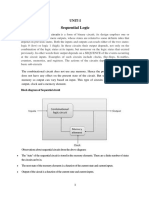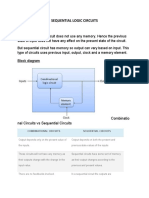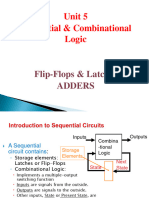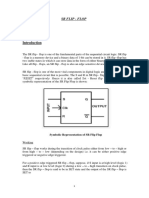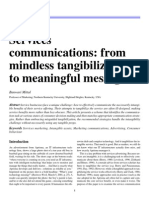Mapua University School of Information Technology: Experiment No. 6 The Flip-Flop
Uploaded by
Tine PalileoMapua University School of Information Technology: Experiment No. 6 The Flip-Flop
Uploaded by
Tine PalileoMAPUA UNIVERSITY
SCHOOL OF INFORMATION TECHNOLOGY
EXPERIMENT NO. 6
THE FLIP-FLOP
PALILEO, PRELAB 10
CHRISTINE MAE G DATA SHEET 25
GROUP NO. 1 ORGANIZATION 5
COMPLETENESS 10
IT160L / BT2 PRESENTATION 10
INTERPRETATION 25
JUNE 8, 2017 CONCLUSION 15
DATE PERFORMED
ADDITIONAL POINTS
JUNE 15, 2017
DATE SUBMITTED
TOTAL 100
_____________________________
Engr. Joel C. De Goma
SCHEMATIC DIAGRAM
WIRING DIAGRAM
SAMPLE PICTURES
PART 1
PART 2
PART 3
INTERPRETATION
In the first part of the experiment, we created the RS Latch
using the NAND Gates. The inputs go through a NAND gate before
passing through the NAND Gate Latch so the input values became
the complement. We have observed that when input S is 1, after
passing the first NAND Gate, and Input R is 0, then Q is zero,
when both inputs are 1, the value becomes invalid.
In the second part of the experiment, we added a clock to
the RS Flip-Flop. We have observed that the same output is given
as with the first experiment when the clock input is 0. When the
clock input is 1, the output becomes its complement.
In the last part of the experiment, the same logic as the first
experiments applies. The change in the outputs is triggered when
the clock input is 1. The difference is that there are no invalid
outputs.
CONCLUSION
The RS Latch using the NAND Gates is the basic Flip-Flop.
The inputs of the Flip-flop are set (S) and reset (R). The inputs are
active low, that is, the output will change when the input is pulsed
low. The basic operations of the latch are:
The clocked RS latch circuit is very similar in operation to the
basic RS Latch. The S and R inputs are normally at logic 0, and
must be changed to logic 1 to change the state of the latch. The
output can only change state while the CLOCK input is a logic 1.
When CLOCK is a logic 0, the S and R inputs will have no effect.
The JK Flip-Flop is designed to overcome the problems of the RS
Flip-Flop, which provides an invalid output when both inputs are
0. The JK Flip Flop is basically a gated RS flip flop with the addition
of the clock input circuitry. When both the inputs S and R are
equal to logic 1, the invalid condition takes place. Thus to
prevent this invalid condition, a clock circuit is introduced. The JK
Flip Flop has four possible input combinations because of the
addition of the clocked input.
References:
http://circuitglobe.com/jk-flip-flop.html
http://hyperphysics.phy-
astr.gsu.edu/hbase/Electronic/nandlatch.html
http://www.play-
hookey.com/digital/sequential/clocked_rs_latch.html
You might also like
- 5 - Flip-Flops and Synchronous Sequential CircuitsNo ratings yet5 - Flip-Flops and Synchronous Sequential Circuits10 pages
- Unit -4 _Sequential building Blocks_ – B.C.A studyNo ratings yetUnit -4 _Sequential building Blocks_ – B.C.A study19 pages
- Chapter 7 - Synchronous and Asynchronous Sequential LogicNo ratings yetChapter 7 - Synchronous and Asynchronous Sequential Logic18 pages
- Lab # 6: Study of Various Flip-Flop CircuitsNo ratings yetLab # 6: Study of Various Flip-Flop Circuits8 pages
- Chap 4 Sequential Logic Circuits - FlipflopsNo ratings yetChap 4 Sequential Logic Circuits - Flipflops31 pages
- Basic Flip Flops in Digital ElectronicsNo ratings yetBasic Flip Flops in Digital Electronics10 pages
- Module 2 Chapter-5-Sequential Circuits -WM (2)No ratings yetModule 2 Chapter-5-Sequential Circuits -WM (2)67 pages
- Digital Logic and Computer Design : Latches and Flip-FlopsNo ratings yetDigital Logic and Computer Design : Latches and Flip-Flops26 pages
- Learn Digital and Microprocessor Techniques on Your SmartphoneFrom EverandLearn Digital and Microprocessor Techniques on Your SmartphoneNo ratings yet
- Group Assignment: Introduction To Object Oriented Programming (IOOP) - CT044-3-1-IOOPNo ratings yetGroup Assignment: Introduction To Object Oriented Programming (IOOP) - CT044-3-1-IOOP19 pages
- Handout on Chapter 3 Kinetics of ParticlesNo ratings yetHandout on Chapter 3 Kinetics of Particles63 pages
- Course Code-Bosw311 (International Relations) and BDVS314 (Development Studies)No ratings yetCourse Code-Bosw311 (International Relations) and BDVS314 (Development Studies)3 pages
- Getting Started With Energyplus: Basic Concepts Manual - Essential Information You Need About Running EnergyplusNo ratings yetGetting Started With Energyplus: Basic Concepts Manual - Essential Information You Need About Running Energyplus75 pages
- AA-SM-009-001 Lug Analysis - Shear Bearing StrengthNo ratings yetAA-SM-009-001 Lug Analysis - Shear Bearing Strength3 pages
- Lesson Plan On Effect of Topical Insulin in Healing Foot UlcerNo ratings yetLesson Plan On Effect of Topical Insulin in Healing Foot Ulcer10 pages
- Carolyn - Matira@ub - Edu.ph: Written and Programming AssignmentsNo ratings yetCarolyn - Matira@ub - Edu.ph: Written and Programming Assignments2 pages















